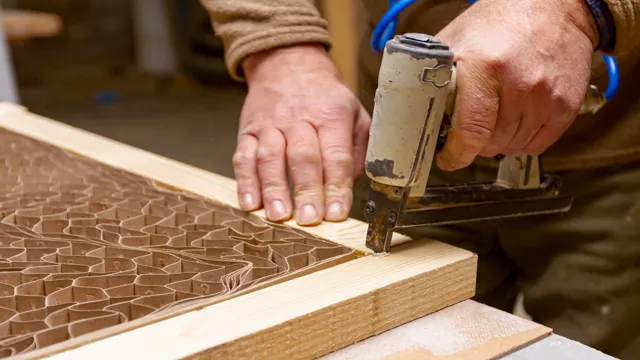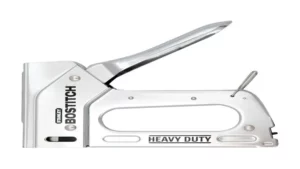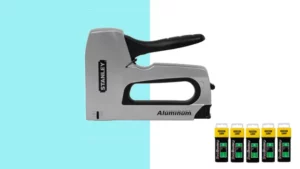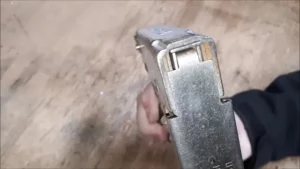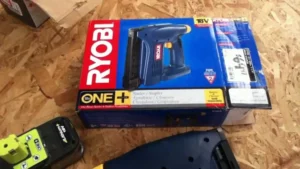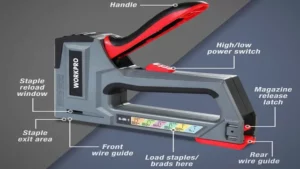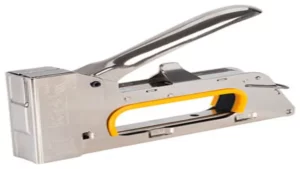Have you ever tried to staple wood together? Maybe you’ve been DIY-ing a project and found yourself struggling to get the staple to penetrate the wood properly. Or maybe you’re just curious about whether using a staple gun and wood is even possible. Well, the good news is, it is! However, there are a few things you need to know before you start stapling away.
Firstly, not all staple guns are created equal. When it comes to stapling wood, you’ll want to invest in a heavy-duty staple gun with enough power to penetrate through the wood. This is especially important if you’re working with thicker or denser woods.
Secondly, it’s important to choose the right type of staple for the job. Heavy-duty staples are designed for use with dense materials like wood, while lighter staples are better suited for softer materials like fabrics or paper. Of course, stapling wood isn’t as simple as just pulling the trigger on your staple gun.
You’ll need to take the time to properly align the pieces of wood and ensure that they’re securely held together before you start stapling. Overall, stapling wood with a staple gun can be a great way to quickly and easily secure your DIY projects. Just be sure to invest in the right tools, choose the right staples, and take the time to properly align your materials before you start stapling.
Introduction
If you’re looking for a quick and efficient way to secure pieces of wood together, a staple gun seems like a good option. But can a staple gun go through wood? The answer is yes, but it depends on the type of staple gun and the type of wood you’re working with. You’ll need a staple gun with enough power to penetrate the wood, such as a heavy-duty staple gun.
Additionally, softwoods like pine and cedar are easier to staple through than hardwoods like oak or cherry. It’s important to also consider the length of the staple you’re using, ensuring it’s long enough to go through the wood and still leave enough room for it to hold. Overall, with the right equipment and wood, a staple gun can be a practical and efficient option for securing pieces of wood together.
What is a staple gun?
Staple gun is a simple woodworking tool that has a unique mechanism to drive metal staples or nails into wood, paper, or other soft materials. This versatile tool is popular among DIY enthusiasts, woodworkers, and construction workers because it makes their work easier and faster. Unlike a traditional hammer and nail, a staple gun can insert staples or nails with a single press of a trigger.
Most staple guns also come with different sizes of staples or nails, making them suitable for different types of projects. Plus, they come in various shapes and sizes, from manual staplers to electric or pneumatic staple guns. So, whether you’re working on a small DIY project or a large construction job, using a staple gun can save you both time and effort.
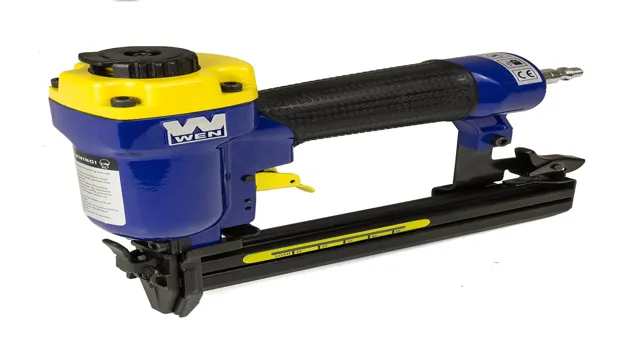
Types of wood
Wood is one of the most versatile and widely used materials in the world. There are a vast number of different types of wood that are used for various purposes, including construction, furniture making, and decorative purposes. Each type of wood has its unique characteristics, making it suitable for specific applications.
The choice of wood depends on a range of factors, including the intended use, strength, and durability required, and personal preferences. Some of the most popular types of wood used in these applications include oak, pine, cherry, maple, mahogany, and teak. Each of these woods has unique properties, such as hardness, grain pattern, texture, and color, which make them suitable for different applications.
Oakwood, for instance, is highly prized for its excellent strength and durability, making it ideal for use in furniture making and construction. Pine, on the other hand, is a softwood that is commonly used for making doors, window frames, and wall panels. Understanding the different types of wood available is essential for achieving the desired results in any woodworking project.
Can staple gun penetrate wood?
A staple gun is an essential tool for anyone looking to complete DIY projects around the home quickly and easily. However, the question arises: can a staple gun penetrate wood? The answer is yes, but it depends on the type of wood you’re using and the strength of the staple gun you’re operating. Softwoods like pine and cedar are more accessible for staple guns to penetrate, but hardwoods like oak and maple are much more durable and can require a more powerful staple gun.
Staple guns with higher gauge ratings and longer staples can typically handle thicker pieces of wood more effectively. Whether you’re a homeowner working on a small woodworking project or a professional contractor, it’s essential to choose the right staple gun to ensure your project is successful.
Factors Affecting Penetration
Can a staple gun go through wood? Yes, it can. However, there are several factors that can affect the penetration of a staple gun in wood. The type and size of the staples, the thickness and density of the wood, the angle of the staple gun, and the pressure exerted on the trigger by the user are all factors that can impact the penetration of staples into wood.
Thicker staples and denser wood may require higher pressure and a different angle for optimal penetration. Additionally, a staple gun with a higher PSI can also aid penetration. It’s important to ensure that the staple gun being used is appropriate for the type of wood and staples being used to achieve the desired results.
Staple size
Staple size can greatly affect the penetration of staplers. It refers to the length of the legs of the staple, which determines how deeply the staple can penetrate the material being stapled. There are several factors that can affect the effectiveness of stapling, including the thickness and density of the materials being stapled together, as well as the size and type of the stapler being used.
When choosing the right staple size, it’s important to consider the specific application, as well as the materials being stapled together. A smaller staple size may be more appropriate for thinner materials, while a larger staple size may be needed for thicker materials. Ultimately, the key is to choose the right staple size for the job at hand, in order to achieve the best possible results.
Staple gun pressure
When it comes to staple gun pressure, there are a number of factors that can affect the penetration of the staple into the material you are working with. One of the most important factors is the type of material you are working with. For example, if you are working with a hard, dense material like hardwood, you will need more pressure to get the staple to penetrate than you would if you are working with a softer material like pine.
Another factor to consider is the type of staple gun you are using. Different types of staple guns have different levels of power, which can affect the amount of pressure you need to apply in order to get the staple to penetrate. Other things to consider include the size and shape of the staple, as well as the angle at which you are holding the staple gun.
Overall, the key to getting good staple penetration is to experiment with different levels of pressure and pay attention to how the staples are penetrating the material. By doing this, you can fine-tune your approach and get the best results every time.
Wood thickness and density
When it comes to wood thickness and density, there are a number of factors that can affect the penetration of finishes and sealers. One of the biggest factors is the porosity of the wood itself. Woods that are more porous, such as softwoods like pine and fir, will typically allow for more penetration than denser hardwoods like oak and maple.
Another important factor to consider is the age and condition of the wood. Older, more weathered wood may have more cracks, knots, and other imperfections that can affect how well finishes and sealers are absorbed. Finally, the type of finish or sealer being applied can also impact penetration.
Some finishes may be designed specifically for use on certain types of wood, while others may be more versatile and can be used on a wider variety of materials. By taking into account all of these different factors, you can better understand how to achieve the best possible results when applying finishes and sealers to wood surfaces.
Choosing the Right Staple Gun
If you need to staple wood, it’s essential to choose the right staple gun. Before buying one, consider the type of wood you’ll be using and the thickness. If you’re dealing with softwoods like pine or fir, a basic stapler with a low-pressure setting can work well.
However, if you’re working with dense hardwoods, you’ll likely need a heavy-duty stapler with higher pressure and longer staples. So, the answer is yes, a staple gun can go through wood, but it depends on the type of wood and the stapler you’re using. It’s crucial to read the manufacturer’s recommendations and choose the right staples for your project.
Don’t be tempted to use a regular office stapler for wood, as it could damage the wood and potentially cause injury. Always prioritize safety and research the right tools for your DIY or professional woodworking project.
Type of Project
When you’re choosing a staple gun, it’s essential to know the kind of project you’re working on. Different staple guns are made for different purposes, and you don’t want to end up with the wrong one. For instance, if you’re working on upholstery or crafting, you’ll need a lightweight staple gun that’s easy to maneuver.
A manual or electric staple gun is perfect for this kind of work. Meanwhile, a heavy-duty staple gun is ideal for construction and carpentry projects. These guns come in both manual and pneumatic (air-powered) designs and are capable of handling thicker materials like wood.
Ultimately, the key to choosing the right staple gun for your project is to consider the materials you’re working with, the amount of use you’ll get out of the gun, and the type of work you’ll be doing. By taking these factors into consideration, you’ll be able to select the perfect staple gun for your project.
Staple Size
When it comes to choosing the right staple gun, staple size is an essential factor to consider. The size of staples affects the strength and durability of the fastening, so it’s important to select the right size for your particular project. For example, if you’re working with thin materials, such as fabrics or paper, smaller staples, like ¼ or 3/8 inches, may be sufficient.
However, thicker materials, like wood or metal, might require larger staples, such as ½ inch or 5/8 inch. It’s always best to check your staple gun’s manual to find out the recommended staple sizes for the materials you’re working with. Using the proper staple size will ensure a secure and long-lasting hold, keeping your project in place for years to come.
Safety Tips
Staple guns are often used to fasten materials together, including wood. However, the question of whether a staple gun can go through wood is a valid concern. The answer depends on the type of staple gun and the thickness of the wood.
A heavy-duty pneumatic or electric staple gun can easily penetrate thicker pieces of wood, while a manual staple gun may struggle with denser woods. It’s important to always wear safety glasses and work gloves when operating a staple gun, as well as ensure the gun is properly loaded and aimed before use. Additionally, it’s essential to use the correct size staples for the project at hand to avoid damaging the wood or causing injury.
By following these safety tips, anyone can use a staple gun on wood effectively and safely.
Use the right safety gear
When it comes to safety at work or during activities like sports or DIY projects, it’s crucial to use the right safety gear. Whether it’s protective eyewear, helmets, gloves, or safety shoes, the right gear will provide adequate protection against potential injuries or accidents. For instance, if you’re working with power tools, the right type of gloves can safeguard against cuts or burns, while goggles can protect your eyes against debris or flying objects.
Similarly, if you’re playing sports, a helmet can protect your head against concussions or other head injuries. So, always invest in the right safety gear and make sure to wear it correctly before engaging in any potentially dangerous activity. Remember, it’s better to be safe than sorry, and a small investment in your safety can prevent a lifetime of regret.
Always keep the staple gun pointed away from you
When it comes to using a staple gun, safety should always be a top priority. One of the most important rules to remember is to always keep the staple gun pointed away from you. Whether you’re working on a DIY project or using a staple gun in a professional setting, accidents can happen in the blink of an eye.
By pointing the staple gun away from you, you’ll reduce the risk of accidentally shooting yourself or others. Additionally, make sure to wear protective gear such as gloves and eye goggles to further minimize the chance of injury. Remember, a staple gun is a powerful tool that should be used with caution.
By following simple safety tips such as keeping the staple gun pointed away from you, you’ll be able to complete your projects safely and efficiently.
Avoid using too much force
When it comes to DIY projects or home repairs, it’s important to remember that safety should always come first. One common mistake people make is using too much force when handling tools or equipment. This not only increases the risk of injury but can also damage the item you’re working on.
So, take your time and carefully assess the situation before starting. Use the appropriate tool for the job and don’t force anything that isn’t meant to be moved or adjusted. Applying excessive pressure or using a tool incorrectly can cause harm and lead to costly repairs or replacements.
Remember, it’s better to be safe than sorry. So, take the necessary precautions and avoid using too much force in your DIY projects. Stay safe and have fun!
Conclusion
In conclusion, while a staple gun may not be the most powerful tool in your DIY arsenal, it can indeed go through wood, albeit with limitations. The size and thickness of the wood, as well as the strength and size of the staples being used, all play a role in the success of your project. So next time you’re wondering if your trusty staple gun can handle the job, remember that with the right staples and a little bit of patience, anything is possible.
Happy stapling!”
FAQs
1. What kind of staple gun is needed to go through wood? A: A heavy-duty staple gun with the appropriate size of staples is necessary to go through wood. 2. Can a regular staple gun go through a thin wooden board? A: Yes, a regular staple gun with longer staples can go through thin wooden boards. 3. What is the maximum thickness of wood that a staple gun can handle? A: The maximum thickness of wood that a staple gun can handle depends on the type and size of the staple gun. 4. How do you prevent splitting the wood when using a staple gun? A: Use the appropriate size of staples, and make sure to staple along the grain of the wood and avoid stapling near the edges. 5. Can a staple gun replace nails or screws when building wooden structures? A: It depends on the type and size of the wooden structure. For larger and more load-bearing structures, nails or screws are recommended. 6. What is the best way to remove staples from wood? A: Use needle-nose pliers to grip the staple and carefully pull it out, or use a staple remover tool. 7. Is it safe to use a staple gun on treated lumber? A: Yes, it is safe to use a staple gun on treated lumber, but make sure to use the appropriate type of staple that is compatible with treated wood.
